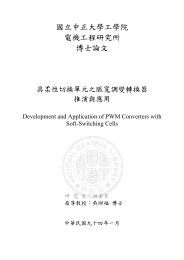Syntax of the Bi Comparative Construction in Mandarin Chinese
Syntax of the Bi Comparative Construction in Mandarin Chinese
Syntax of the Bi Comparative Construction in Mandarin Chinese
Create successful ePaper yourself
Turn your PDF publications into a flip-book with our unique Google optimized e-Paper software.
<strong>Syntax</strong> <strong>of</strong> <strong>the</strong> <strong>Bi</strong> <strong>Comparative</strong> <strong>Construction</strong> <strong>in</strong> Mandar<strong>in</strong> Ch<strong>in</strong>ese<br />
<strong>the</strong> idea <strong>of</strong> common predicte <strong>of</strong> BCC <strong>in</strong> <strong>the</strong> surface structure may br<strong>in</strong>g some<br />
problems shown <strong>in</strong> (39). If <strong>the</strong> first comparative clause is <strong>the</strong> antecedent clause, <strong>the</strong>n<br />
<strong>the</strong> elliptical clause can have only <strong>the</strong> mean<strong>in</strong>g <strong>of</strong> only (39b), not (39c).<br />
(39) a. Zhangsan bi Lisi congm<strong>in</strong>g, Wangwu ye shi<br />
Zhangsan COM Lisi smart Wangwu also AUX<br />
‘Zhangsan is smarter than Lisi, and so does Wangwu.’<br />
b. Zhangsan bi Lisi congm<strong>in</strong>g, Wangwu ye bi Lisi<br />
Zhangsan COM Lisi smart Wangwu also COM Lisi<br />
congm<strong>in</strong>g<br />
smart<br />
‘Zhangsan is smarter than Lisi, and so does Wangwu.’<br />
c. Zhangsan bi Lisi congm<strong>in</strong>g, Wangwu ye hen congm<strong>in</strong>g<br />
Zhangsan COM Lisi smart Wangwu also very smart<br />
‘Zhangsan is smarter than Lisi, and Wangwu is very smart, too.<br />
Hs<strong>in</strong>g th<strong>in</strong>ks that sentences like (39a) should be analyze as “[Zhangsan] [VPbi Lisi<br />
congm<strong>in</strong>g]” not “[Zhangsan bi Lisi] [VPcongm<strong>in</strong>g]”. In o<strong>the</strong>r words, <strong>the</strong> second<br />
compared items should be <strong>of</strong> <strong>the</strong> adjunction relationship to <strong>the</strong> ma<strong>in</strong> predicate.<br />
2.2.3 Adjunction Analyses<br />
2.2.3.1 A Transformational Analysis (Fu 1978)<br />
Fu (1978) studies <strong>the</strong> Ch<strong>in</strong>ese CC with bi under a transformational framework.<br />
He proposes a hypo<strong>the</strong>sis that <strong>the</strong> underly<strong>in</strong>g structure <strong>of</strong> BCC consists <strong>of</strong> three<br />
clauses as shown <strong>in</strong> (a). He takes <strong>the</strong> abstract bijiao ‘compare’ as a predicate which<br />
takes two parallel propositions as its arguments. The two compared propositions, S1<br />
22<br />
中正大學 e-Thesys (94 學年度)





